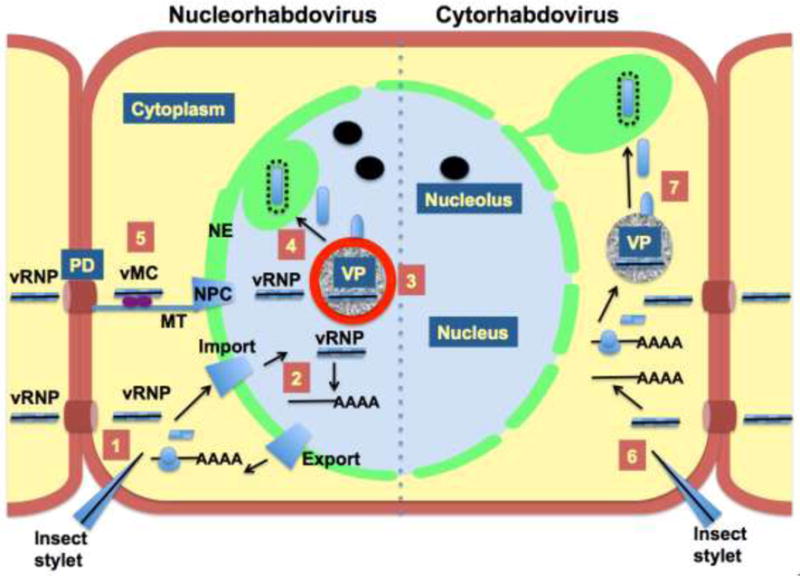Fig. 5.

Comparison of the infection cycles of nucleo- and cytorhabdoviruses in plant cells. 1. Nucleorhabdoviruses are initially introduced into plant cells via a mechanical breach of the cell wall by insect vectors or experimentally by abrasion. The introduced viral ribonucleoprotein (vRNP) is imported into nucleus due to interaction with the nuclear import receptor importin-alpha. 2. Within nucleus the vRNP establishes transcription of poly(A)+ transcripts that are exported from the nucleus. Translation of the viral mRNAs in the cytoplasm produces proteins that are imported into nucleus where they aggregate to form the nuclear viroplasms where replication occurs (VP). 3. Nascent nucleocapsids are condensed on the perimeter of the VP, which is enriched in the phosphoprotein (sonchus yellow net virus, SYNV; Goodin, unpublished). 4. Matrix protein condensed nucleocapsids bud into the perinuclear space where mature virions accumulate. In the case of SYNV, the inner membrane of the nuclear envelope (NE) invaginates into the nuclear VP to form virus-containing spherules. 5. Mature virions do not move cell to cell, but may be transmitted to other plants via insect feeding. The vRNP exits the nucleus using the nuclear pore complex (NPC). In the cytoplasm the viral movement complex (vMC) is composed of the vRNP, the viral movement protein, and host factors, which are trafficked towards plasmodesmata (PD) on microtubules (MT), resulting in cell-to-cell spread of the virus. 6. Cytorhabdoviruses are introduced into cells in a manner similar to nucleorhabdoviruses, but carry out their replication cycles in the cytoplasm. 7. Transcription and translation of cytorhabdovirus vRNPs produce the protein pools required to form cytoplasmic VPs for replication. Condensed vRNPs mature in cytoplasmic proliferations on endoplasmic membranes. As above, mature virions do not move from cell to cell, and cytorhabdovirus vRNP are expected to traffic to the PD via a similar vMC mechanism.
